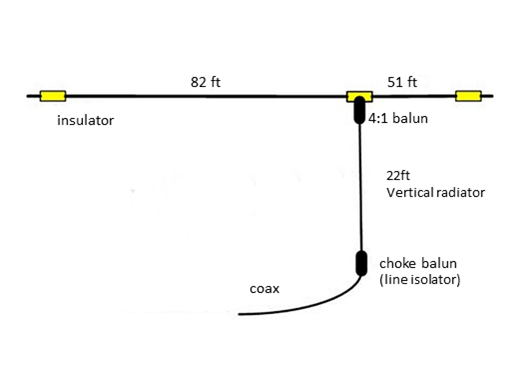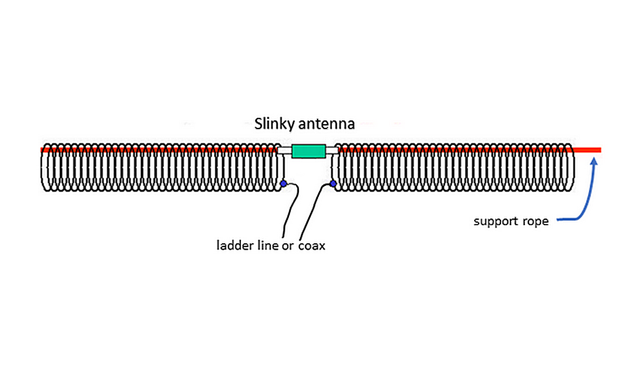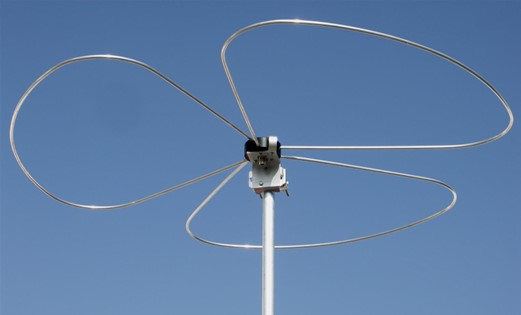We’ve all heard of Yagis, dipoles, and G5RVs. But there are other antennas out there that are a bit unusual—either by name or configuration. One even grows…
Carolina Windom
Going to Carolina in your mind? Carolina Windoms are basically Off-Center-Fed Dipoles (OCFD) with a few twists. This antenna changes the feed slightly to 38% off-center and makes a section of the coaxial feedline part of the antenna, radiating RF. In the case of normal dipoles, we try to avoid this from happening. But in this case we want the feedline to radiate!

By letting it do so, the outer shield of the vertical coax radiates to fill in the gaps in the signal pattern radiated by the top portion of the antenna. A 1:1 choke balun at the bottom of the 22-foot radiating vertical isolates it from the coaxial feedline going down to the transceiver. This prevents RF from being fed back into the radio operation position.
With the modification, a Carolina Windom becomes a nearly omnidirectional antenna with a low angle of radiation, suitable for DX work. This is a desirable characteristic, especially on the lower bands—40, 80, and 160 meters.
Moxon
The Moxon antenna is rectangular. Slightly less than half of the rectangle is the driven element and the other slightly more than half part is the reflector. It’s basically a two-element antenna with folded dipole components about 70% the length of a full size two-element Yagi. However, the Moxon far exceeds other two-element beams in front-to-back ratio, and nearly equals them in gain.
Moxon antennas are popular with amateur radio enthusiasts for simplicity of construction. There are just two elements and insulators—no traps, coils, or matching networks.
VHF/UHF portable Moxons are favored by radio amateurs for Field Day and for emergency communications use because of their lightweight and robust construction. HF versions are available, such as the OptiBeam OB2-40M-P, but 40m is the largest practical size for most installations.
It’s a Toy—It’s an Antenna
The Slinky is just a helical spring, a classic toy that’s “fun for a girl and a boy,” as the commercials used to say. But once you roll your Slinky down the stairs a few times, it’s run out of entertainment value. So what can you do with those neglected Slinkys gathering dust on the shelf?
As it turns out, a Slinky makes a reasonably good limited-space antenna. Smithsonian Magazine mentioned that they were used during the Vietnam War. Soldiers would sometimes use a Slinky as a portable, extendable antenna tossed over a tree branch to get a clear signal. Hams learned to solder an RF connector to two Slinkys forming a dipole, then run a support rope through them and stretch out in opposite directions. When it’s stretched to a length between 5 and 15 feet, a standard Slinky coil resonates as a quarter wave between 7 and 8 MHz. To make it resonate at higher frequencies, tune by shorting-out turns by pushing a number of turns up against each other and securing with a clip. Another way is to stretch them as far as space permits and connect them to an antenna tuner/coupler via a feedline made of twin-lead or ladder line.

Skeleton Slot Antennas
Can a hole be an antenna? Well, sort of. Technically, the edge of the conductor around the hole is the antenna.
Skeleton slot antennas are a version of the folded dipole. They can be easily rotated and are bidirectional. Skeleton slots have high gain, a low angle of elevation, wide bandwidth, and performance similar to a two-element Yagi. A vertical skeleton slot radiates like a horizontal dipole and has horizontal polarization—good for limited space.
There are several variations including:
- Planar slot—microstrip and patch antennas
- Skeleton sleeve—ladder line antenna notched for multiple bands
- Hentenna—like skeleton slot, with feedpoint off-center
Big Wheel
We’re not talking about the low-rider tricycle made for kids, but a horizontal antenna. The Big Wheel antenna, when viewed from the top, looks like a shamrock or three-leaf clover configuration. The three elements are usually constructed of aluminum rods or tubing.
In the horizontal plane, the wheel has a gain of a couple of dBs more than the typical resonant dipole or turnstile antenna. Two of these antennas vertically stacked will achieve about 5 dBd gain with a monoband power divider or coaxial phasing harness that connects two same-band antennas to one coax feedline. It’s also possible to stack multiple bands together on the same mast, such as 2 meters and 70 centimeters.
The WiMo Big Wheel Horizontal Loop Antenna pictured below covers 2 meters and is about 44.5 inches in diameter. It’s also available in 6 meter and 70 centimeter versions.

Sprucing Up Your Antenna Farm
I think that I shall never see an antenna as lovely as a tree.
In 1904, General George O. Squier, U.S. Army chief signal officer, developed the theory that trees were nature’s own wireless towers. During World War I, his theory was tested and found that it was possible to receive radio signals through a tree. Tree communication was also used during the Vietnam War when U.S. troops in the jungle needed a reliable and easy-to-transport system of communication.
Navy researchers invented a novel technology that can turn a live tree into a multiple frequency broadband antenna. One or more current probes are attached to a tree at various positions such as the trunk and supporting branches. The tree as a whole becomes a fully functional antenna. The size of the current probe determines the specific frequency response, which suggests that one tree could support many different communication devices.
Current versions use flexible metal spring that wraps around the trunk, since Squier’s method of planting a nail into the tree would damage it. This coupling coil is more environmentally friendly.
Skeptical? A group from Baltan Labs in the Netherlands staged a working demonstration. Their team managed to communicate with amateur radio operators from countries as distant as Italy and Ukraine. At the very least, you’ll have the local HOA scratching their heads.

